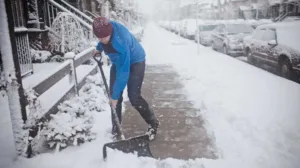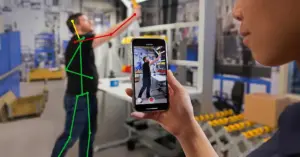By Phil Molé, MPH
The holidays are here! You’re likely making a list, checking it twice, and making plans to be with the special people in your life. And no doubt, you’re still hard at work right up to the holidays, which is all the more reason to make sure you’re not overlooking important safety hazards and risks in the workplace.
The last thing you want is for a workplace injury to interfere with your ability to be with and enjoy your time with those who matter most to you. Unfortunately, many companies report an uptick in accidents during this time of the year, due to a combination of factors ranging from winter weather conditions and short-staffing to distractions, and even dangers associated with holiday decorations.
In what follows, you’ll learn some holiday safety tips about common hazards to watch out for while working during this time of the year and get some key takeaways about how to make sure that you and your whole team leave work safely every day.
Holiday Safety Tip #1: Deck the Halls, But Don’t “Daisy Chain” the Lights
“Daisy chaining” refers to the process of connecting two or more extension cords or surge protectors, usually to plug in something we want to position farther away from our existing electrical outlet or surge protector. Most of us have probably resorted to daisy chain connections at some point in our lives, and the temptation to string those extension cords together grows around the holidays, when we may be trying to find creative ways to light up our decorations.

Why is daisy chaining dangerous? When you connect multiple cords or surge protectors, you’re placing more demand for electrical power on the outlet your motley chain of devices is connected to than the outlet is designed to provide. Overtaxing the outlet or surge protector that your daisy chained cords connect to creates an elevated risk for an electrical fire. This is why OSHA prohibits daisy chain connections in their general requirements in 1910.303 within Subpart S (Electrical), and why many other electrical standards prohibit the practice, as well.
While you’re at it, you should also make sure that no extension cords pass through doors or windows, because OSHA regulations don’t allow that, either. 1910.305 states that installations can only have cords that pass through doors, windows, or holes in walls on a temporary basis. Technically, “temporary” would apply to holiday decorations, but beware of being too lax here, for two reasons. The first reason is that people often get the idea of running cords through doors and windows while decorating for the holidays because they’re already doing it throughout the rest of the year. The second reason is that temporary installations have a way of becoming permanent, intentions to the contrary. Maybe the light-up Frosty the Snowman won’t be plugged into the cord flopping down through a window, but if someone took the trouble to string that cord through, there’s a good chance that the cord will stay there, and something will be plugged into it.
Check the condition of extension cords and power strips to be sure they’re ready for use. Don’t use any cords with damaged insulation or plugs. Also, make sure you’re not burying the extension cords you use underneath carpets and rugs in high traffic areas, which can lead to trip hazards.
Holiday Safety Tip #2: Beware of the Woes of “Santa Snow”
Spray-on artificial snow, often marketed under names like “Santa snow” or “Instant Xmas snow,” is commonly used for decorating indoor trees and windows. These products contain gas propellants, such as butane, propane, and heptane, which are held under pressure—creating a potential explosive hazard. Make sure you’re not placing decorations coated with “Santa Snow” or spraying the snow anywhere near ignition sources, such as sparking tools or ovens.
They also may contain alcohols such as ethanol or ethoxylated fatty alcohol, and solid additives such as titanium dioxide and calcium carbonate for texture and color. Because of these ingredients, these spray-on artificial snow products can cause skin or eye irritation in the event of contact. Make sure that any team members in charge of applying the spray-on snow are aware of these risks.
Access to emergency response services can provide an extra level of protection, because you may not have an SDS on hand for consumer products like “Santa snow.” Emergency response services give you access to a 24-hour support hotline with live experts, so you can get in-the-moment feedback on exposure symptoms and first aid measures to take.
Holiday Safety Tip #3: Manage the Challenges of Working with a Smaller Headcount
There are things about the holiday season to look forward to— having time off to spend with friends and family or just relaxing after a year of hard work. There are also some things you to avoid during the holidays, such as getting seasonal illnesses like the cold or the flu that may shelf you for a while and put a real damper on the holiday cheer.
The common denominator is that during this time of the year, there are a lot of reasons why some of the people you work with won’t be around, and that can have a negative impact on safety. There are really a couple of ways that reduced staff can create, or at least exacerbate, EHS risks.
People who know the right ways to do the work are missing in action, and no one else knows what to do. When all the information is in one person’s head, if they’re gone, the awareness of the right ways to do the job and associated safety measures are gone, too. In other words, the company has a person to manage safety, when they really need a system to manage safety.
Another issue that results from short-staffing is that there may not be enough people on hand to conduct the physical demands of the job. For example, work at an assembly table may involve lifting parts from the floor or the shelf onto the table, which may be easily done when two people are on hand. But if one of those two people is off work (due to illness, injury, or scheduled PTO), will the other person be tempted to try the lift alone? Quite possibly, especially if the person is feeling pressured to get things done as quickly as possible.
You’ll need to consider both of these trends related to a temporarily smaller headcount throughout the holidays. The end of this article will discuss some of the high-level takeaways to address these challenges, but the spoiler alert is that it boils down to proactive safety management.
Holiday Safety Tip #4: Preparing for Winter Weather Conditions
In at least some parts of the world, the winter season comes with colder and sometimes dangerous weather conditions. Snow and sleet cover sidewalks, streets and parking lots. Strong gusts of wind may occur, and windchill factors can create dangerous exposure conditions.

Some of the accidents and injuries that may occur from these winter hazards include:
Slips/falls: Parking lots and walkways at work may become slippery due to snow and “wintry mix” cover. As snow melts and then refreezes, some walking surfaces may also be covered with thin sheets of ice that may be difficult to see, especially when leaving work at night.
Auto accidents: Poor driving conditions due to snow, sleet and ice coverage may lead to vehicle accidents.
It’s worth a reminder, for those of us in the US, that some vehicle accidents may also be OSHA-recordable injuries if they occur outside of the normal commute and associated employee injuries meet OSHA recording criteria, such as days away from work, restricted duty work, hospitalization or other medical treatment. Additionally, some employers forget that slips/falls that occur on the employer’s property before or after work begins, or on breaks during the workday, are still considered to occur in the work environment and would be recordable if other recording criteria (medical treatment, days away from work, etc.) are met.
More information about OSHA’s Recordkeeping Standard is in our on-demand webinar.
Holiday Safety Tip #5: “Tis the Season for Managing Distractions
Your ability to work safely depends in part on your awareness of safety risks, and your awareness of safe work procedures.
You can probably remember some accidents that happened when people did not have their peak powers of concentration. For example, an employee who’s tired will be less attentive to the safety aspects of their job, such as ensuring that proper controls are in place. Another classic example is the employee who works a full day at work safely, but as soon as their workday is over, they get into an accident, such as by removing their safety glove and then setting their hand down on a sharp object or bumping into machinery on their way out of the facility.
There are plenty of opportunities for distractions during the holiday season. Some employees may be worrying about finding time to buy Christmas presents for their kids or worrying that they won’t have enough money to buy Christmas presents. They may be looking out the window at the falling snow and getting anxious about their evening commute. Or they may be stressed out because they’re working without the usual support they get from coworkers who are now out on vacation and aren’t sure they’ll be able to get through it all.
Being mindful that distractions can happen is the first step toward being able to manage them. The second step, as you’ll learn more about at the end of this article, is to have a proactive safety management approach that gives all of your employees the information they need about workplace risks and the controls they need to have in place to work safely.
Holiday Safety Tip #6: Weathering a Perfect Storm of Safety Risks
Winter weather conditions can be especially dangerous because sometimes, you don’t just get one bad weather condition in isolation. Sometimes, all the bad things come at once. For example, in a real storm, strong winds sometimes accompany massive amounts of snow and rapidly plummeting temperatures immediately after. Similarly, safety risks have ways of piggybacking and leading to more severe outcomes.
Here’s a typical holiday-season “perfect storm” scenario. Imagine that you’re working in an assembly department within a factory, and your normal job involves joining several components together to form a single product and then packaging the part for shipment in commerce. You normally have a partner working with you who helps “team-lift” the heavier parts onto the table, but your partner is out sick today, and your supervisor hasn’t provided any alternate instructions on how to conduct the job. You hope to just get through the day and head out right at the end of your usual shift time so you can pick up a pie you’ll be bringing to a family holiday dinner in a couple of days.
The day starts out alright, but without your partner, the work is slower, and you start to fall a little behind schedule. You’ve picked up a few of the larger pieces by yourself already without issue, and you think about going to look for material handling equipment to use for the rest, but you’re not sure where they’re at, and don’t want to waste time, so you continue performing the lift manually. But you’re increasingly in a hurry as you continue to fall behind schedule, and you bend at the waist to grab the part instead of at the knees, and you feel a slight twinge in your back. Not good.
Now, you do decide to look for a mechanical cart, and you find one and get back to work. But in early afternoon, you overhear a couple of coworkers talking about the snow forecast, and you walk over to the window, where you can see there’s already a first blanketing of snow on the cars in the parking lot. You try to put it out of your mind and go back to work, but there’s a part of your mind that’s thinking about that snow and thinking about how you’re running late on getting the work done, and wondering how long it will take to get to the bakery after work and get home.
By the time you’re done putting the last packaged part on the shelf and returning the mechanical cart, you’re a little over 30 minutes past your usual quitting time. You throw your jacket on and grab your bag and head out the door to the parking lot, where you can see that your car is pretty well covered with snow. You pitch your shoulders forward and break into a brisk stride to get your car and start sweeping the snow off, take about three steps, then suddenly find your foot flying up into the air as you slip on a patch of ice hidden by the snow. Part of the reason for your fall may be that your twinged back makes you less flexible than usual and more prone to falls—a trend borne out by a prospective study.
You land flat on your back, hard. Your thick winter coat cushioned your fall a bit, but you find that the slight twinge you felt earlier now feels like a full-blown strain, and your back is so stiff that you can barely get yourself upright. As a result, you wind up missing a couple of days of work, and getting a prescription for anti-inflammatory medication, which makes the incident an OSHA recordable injury in the United States.
What about the pie, you ask? Someone else was able to pick it up the next day, so you didn’t have to rush, after all, and if you hadn’t, you just might have avoided a slip and an injury.
It’s not one thing that led to this incident – it was many things. And a busy time like the holidays is when coworkers are more likely to be out, winter weather conditions will often make a slippery mess of roads, and you’ll be nervous about all these things, and that one day will be when all the bad things happen together.
Key Takeaways About Workplace Safety During the Holiday Season
These holiday safety tips have hopefully reminded you that this time of the year isn’t all eggnog, hot cocoa and sliced turkey (or for the vegetarians out there, sliced tofurkey). But a big part of safety management concerns “lessons learned” when something bad happens, and there’s no point in talking about the bad things that can happen without discussing how to stop the bad things from happening. As Ebenezer Scrooge pleaded with the Ghost of Christmas Future: “Spirit! Are these the shadows of the things that will be, or are they shadows of the things that may be only? Why show me this, if I am past all hope?”
You’re not past all hope. Here are the key takeaways you’ll need for a safer and happier holiday season.
You Need an Active inspections Program
Inspections are one of the most common tools in the EHS professional’s toolkit, but you may not be using them as often or as effectively as you could be. Many EHS professionals fall into the habit of doing obvious regulatory-required inspections like forklift inspections or hazardous waste storage location inspections but fall down on doing other inspections related to lesser-known regulations or inspections to identify safety hazards, more generally.

For example, you read earlier in this article about possible fire risks from spray-on “Santa snow,” and potential electrical hazards from daisy chaining extension cords, or permanent wiring setups in which cords pass through doorways or windows. The best way to confirm that you don’t have these hazards in your workplace is to develop tailored inspection checklists you can use, for example, to confirm that no ignition sources are located near decorations containing “Santa snow,” or no wiring setups contain daisy chaining and other hazards.
Look into software that can help you easily create and deploy inspection checklists and access your inspection documentation from anywhere.
Risk Management
All EHS management really boils down to risk management. Your management system needs to focus more broadly on identification of hazards and risks, as outlined in the gold standard for occupational health & safety (OH&S) management, ISO 45001.
A job safety analysis (JSA) is a common type of risk assessment and is considered very effective because it breaks down a job into a number of constituent tasks, so there are fewer places for hazards and risks to hide. Involving front-line workers who do the job every day and understand the risks in the process of developing a JSA is a great way to ensure that you get good-quality input, and that everyone is familiar with the contents and purpose of the JSAs. This is especially true because one of the important purposes of a JSA is to identify and describe the controls in place. Controls are methods you use to lower risk exposure levels—reducing the likelihood of a specific bad thing happening or reducing the severity of the outcome if it does happen.
The benefit to doing JSAs and making them accessible to employees is that you’ll have a lot less uncertainty about the “right” way to do a job, and the safety controls that should be in place. Think back to our example of the person working at the assembly table during the holidays. There would have been less chance of confusion about how to do the work safely if the employee was familiar with the JSA, or even better, was involved in creating it.
The problem is that many EHS professionals are still doing JSAs on paper or on desktop applications. Their JSAs are gathering dust in a physical folder in a file cabinet or gathering virtual dust in an electronic file on a computer desktop, and aren’t fulfilling their intended purpose as active, living documents for guiding everyday safe work practices.
The right operational risk management software can help here by giving you and your team a standardized process for completing JSAs, even offering curated lists of applicable controls and their associated risk reduction factors. The software even automatically applies the risk reduction factors, so you and your employees can see what the overall risk rating looks like before and after implementing the controls, and by extension, understand the importance of conducting the job with the controls in place. You’ll also have access to all of your JSAs from a centralized location anytime you need it.
Ergonomics
One category of risks many EHS professionals don’t pay enough attention to concerns risks of musculoskeletal disorders (MSDs), which are injuries to the joints, ligaments, muscles and nerves that result from strains, overexertion, and awkward or repetitive motions while performing physical work. Many employers have not fully implemented an active ergonomics process focused on “designing out” MSD risks whenever possible and using high quality ergonomics assessments to identify existing MSD risks, determine root causes, and select and implement appropriate controls.
Recall the example of our anxiety-ridden employee working at the assembly table before the holidays. The “normal” way to do that job involved a two-person lift to get some of the larger parts onto the assembly table, but a better way would have been to design out the need to lift the part, or barring that, to have made use of mechanical handling devices the default way to do the job. The employee would certainly have had a happier time, and a happier back, if the employer had a robust ergonomics program that assessed the job task, measured their MSD risks, identified root causes, and implemented effective controls.
The most effective modern ergonomics software provides the support needed to do ergonomics right, with 3-D motion capture capabilities you can use on your mobile device to assess the physical forces exerted by employees performing job tasks.

Subject matter expertise from certified professional ergonomists (CPEs) baked into the software then provides a curated list of probable causes, and once the user selects a cause, the software then shows associated controls, so you can actually use your assessment results to start reducing MSD risks.
Proactive Safety Management is the Gift that Keeps on Giving!
Times like these show you a truth that applies not only during the holidays, but also all year long: You need a safety management system, not just a safety management person.
When you have a system, you have more efficient ways of completing your key tasks, like inspections and follow-up actions, with the direct involvement of your team. When you have a system, everyone knows safe ways to do their work, and they understand the importance of the controls. And when you have a system, your safety performance doesn’t fall apart when key people aren’t around, because the information doesn’t only exist in their heads.
Proactive safety management is truly the gift that keeps on giving, because it keeps your entire workforce safe all year long. You’ve learned above about some of the ways that EHS software can help. While software cannot in itself be a management system, because a management system consists of all the people, policies and places involved in safety management at your workplace, you’ll have an easier time being proactive when you have the right software support.
VelocityEHS can help you. Contact us anytime to learn more about the ways our software platform can provide support for your safety, operational risk, and ergonomics needs. Even better, schedule a demo so you can see our software in action for yourself. Start planning now to have the resources in place you need to have a safe and successful 2025.
From all of us to all of you, we wish you a happy holiday season and a wonderful New Year.
